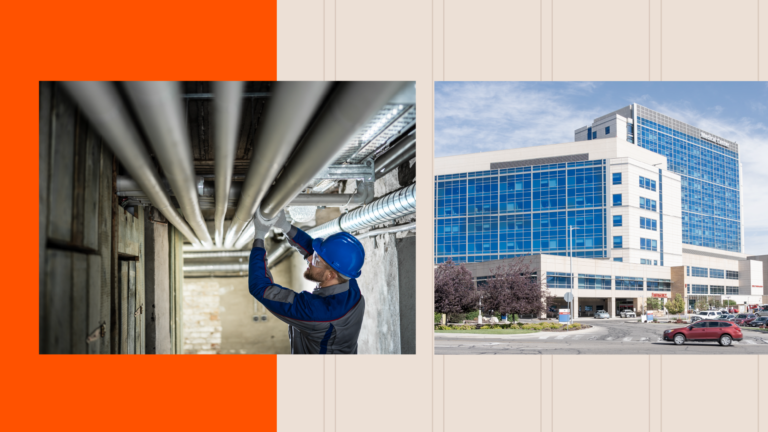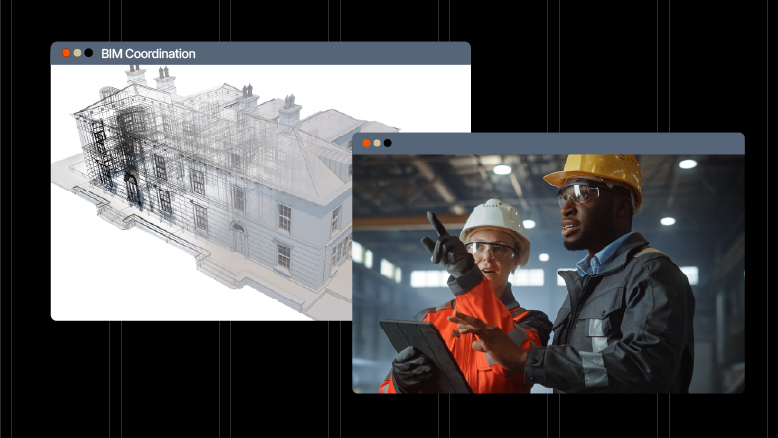— 8 min read
Hospital Plumbing Systems: A Guide for Construction Professionals
Last Updated Mar 18, 2025
Last Updated Mar 18, 2025

Plumbing systems are central to patient safety and operational efficiency in healthcare facilities. These complex systems integrate with mechanical, electrical and plumbing (MEP) elements, and require strict adherence to construction codes and regular maintenance.
Healthcare water systems play a significant role in infection control and emergency responses, so there are many functional components needed to meet the high standards of medical environments. Understanding the intricacies of hospital plumbing helps construction professionals effectively manage and mitigate risks when building or renovating healthcare facilities.
This article provides insights into hospital plumbing systems' design, installation and maintenance, offering best practices to meet the unique demands of healthcare construction projects.
Table of contents
The Role of Plumbing in Healthcare Facilities
Plumbing systems in healthcare settings support patient safety, medical procedures, infection control and sanitation. The basic functions of hospital plumbing include:
- Clean water for patient care
- Sterile environments for surgery and other medical procedures
- Infection control — preventing pathogens’ spread or growth
- Sanitation — providing water for proper hygiene
- Medical equipment requirements, such as dialysis machines
- Waste disposal, including medical waste and hazardous materials
Water needs in hospitals are complex because of the varying levels of purification required, the need to stop backflow to prevent contamination and accessible designs that support regular maintenance and monitoring.
Components of Hospital Water Systems
Healthcare facility plumbing consists of standard and specialty systems and equipment designed to support the safety of patients, employees and the community.
Potable Water System
The domestic water supply for drinking water and general hospital use requires adherence to water quality standards.
Central Sterile and Laboratory Water
To prevent contamination, highly purified water is required for cleaning, disinfecting and sterilizing tools and devices. The system may treat water for these purposes using reverse osmosis, specialized filtration or deionization.
Wastewater and Sewer
Removing wastewater is especially important in a hospital setting because it can contain hazardous contaminants, including pharmaceuticals, toxic chemicals and microorganisms like antibiotic-resistant bacteria. Wastewater usually drains into the sewer system.
Emergency Plumbing System
Backup water supply diversion valves and stored water on site for use during any disruption to the main supply keep the hospital running in any circumstance. Emergency fixtures, such as eye wash stations, showers and designated sinks, need to be in place to handle hazards. Fire sprinkler systems need to be operational.
Regulatory Requirements for Plumbing in Hospitals
Healthcare facilities must comply with regulations from the International Plumbing Code (IPC), the Joint Commission and the Centers for Disease Control and Prevention (CDC).
Additionally, water systems function in conjunction with HVAC systems, so the American Society for Heating, Refrigerating, and Air Conditioning Engineers (ASHRAE) has risk management guidance for plumbing systems. States also have healthcare construction requirements that apply to plumbing systems.
Design Considerations Involving Hospital Plumbing
Water is so essential for healthcare that any disruption or problem can have severe negative impacts on patients. Here are some of the common challenges associated with plumbing systems in healthcare:
Compliance With Multiple sets of Regulations
Like other aspects of healthcare construction, hospital plumbing involves following many regulations. Hospitals are also subject to many inspections to comply with local, state and federal oversight agency requirements.
Regulatory authorities often have a long backlog of reviews and approvals across the entire region they oversee. This means it could be a month or two before an important design change is approved — and if the construction schedule doesn't perfectly coincide with when that point of contact is going to show up and look at something, or even worse, they do show up and look at something, but reject it — it can cost weeks in the schedule.
Grant Honetschlager
Strategic Product Consultant, Owners
Procore Technologies
Reliability and Redundancy
Water availability is so critical for patient care and safety that many parts of the system need backups, such as backup sewage pumps, dedicated plumbing for critical areas and cross-connected drainage systems to route wastewater should one route become blocked. In case one supply line fails, hospital plumbing systems need two separate water service lines connected to separate mains.
Precise Temperature and Pressure Control
Hot water is necessary to help kill bacteria for infection control, but preventing scalding is also a concern. Pressure drops or fluctuations can disrupt healthcare functions such as sterilization, medical procedures like dialysis, fire safety and can compromise hygiene.
Incorporating specialized components like Reduced Pressure Zone (RPZ) and thermostatic mixing valves helps control pressure and temperature.
Infection Control Concerns
Because water can contain, spread or contribute to the growth of pathogens, multiple steps are involved to mitigate infection risks.
Plumbing systems should have capabilities for backflow prevention, leak monitoring and regular flushing to reduce risks from stagnant water. Touchless toilets and faucets also limit infection transmission.
Water Quality Management
Hospitals require robust water quality monitoring in multiple areas and to comply with various standards. The design of hospital plumbing must include monitoring devices such as sensors and probes throughout the water distribution system.
Water treatment with disinfectants like chlorine and different types of filtration helps prevent bacterial buildup and maintain water quality.
Ventilation and Drainage
Proper ventilation prevents sewer gas buildup and facilitates smooth drainage of wastewater. Floor drains in operating rooms, showers and other high-traffic areas keep water from pooling.
Facilitating Preventative Maintenance
Plumbing systems in hospitals require regular inspections to detect leaks, clogs, corrosion, backflow issues and system functionality. Servicing medical waste disposal systems and specialized medical equipment requires unique tools and techniques.
Because water pressure, temperature and quality impact patient safety, keeping all parts of the water system in good repair is complex and requires a system designed for accessibility.
Designing for Cost Efficiency
Hospitals can reduce water bills and maintenance costs by using low-flow fixtures and implementing designs that make monitoring, inspecting and maintaining systems easier.
Smart plumbing systems that automatically detect leaks and control water flow in real time can leverage the power of IoT to connect a control platform to devices within the system, helping streamline management and contain costs. Solar water heating or heat pumps can reduce energy use and graywater recycling can reduce water use.
Flexibility and Futureproofing
Healthcare methods and technology are constantly evolving, so plumbing systems need to be designed to accommodate additions and easily adapt to changes.
The Importance of Water Systems for Hospital Safety
Although plumbing for healthcare settings adds considerable complexity to any construction project, understanding the multifaceted ways that water systems contribute to safety helps reinforce the priority of correctly integrating the plumbing elements into any hospital build.
Here are some of the ways that hospital plumbing contributes to emergency responses:
- Fire suppression from the sprinkler system
- Secondary water supply and backup pumps
- Eye wash stations, showers and designated sinks
- Emergency water supply plan
Pathogens can linger and spread within the water system, so designs need to consider the following infection control issues:
- Water temperature to kill pathogens and inhibit their growth
- Wastewater and medical waste removal
- Hygiene, including proper hand washing
- Filtration and purification for sterilization and medical uses
- Eliminating stagnant water areas that could harbor pathogens
- Managing biofilm buildup in pipes
- Water quality monitoring to test for pathogens and contaminants
- Design for splash prevention that could contain pathogens
- Maintaining water pressure
- Water management plan
Best Practices for Hospital Plumbing Installation
Plumbing challenges in healthcare settings require construction professionals to track, document and communicate to maintain safety. Here are some best practices for work on hospital water systems:
Coordinate with all trades.
Hospital MEP systems are complex, and early involvement of all trades during design can mitigate clashes and prevent rework and delays. Medical gas line installation may fall under the purview of the plumbing contractor or a specialized company, but coordinating water systems with medical gas, HVAC and medical equipment installation is necessary to create a smoothly functioning healthcare facility.
Working with an experienced design team is a necessity for hospital construction. Because these buildings have to adequately house medical gas infrastructure and the mechanical, electrical and plumbing, general contractors should invite specialty trade contractors into early planning meetings to mitigate clashes in the plenary space as much as possible.
Grant Honetschlager
Strategic Product Consultant, Owners
Procore Technologies
Minimize disruption during construction.
Often, healthcare facilities must continue to operate while plumbing is being installed. Strategies to minimize disruption to operations include careful preplanning, isolating areas during work, communicating with hospital staff, using temporary plumbing solutions and prioritizing infection control during installation.
Scheduling around hospital peak times and maintaining clear communication with facility staff like charge nurses and facility managers is key to avoiding impacting healthcare activities.
Understand codes and testing requirements.
Thoroughly research and understand local and national healthcare plumbing regulations to document water system compliance. Before the facility opens, conduct the necessary testing, including pressure, backflow prevention, emergency eyewash and shower systems and water quality analysis. Detailed reports will be required to commission the installation.
Document and plan facility maintenance.
Provide isometric and as-built drawings that include all specifications for maintenance and future hospital plumbing changes.
Devise a maintenance plan that provides for regular inspections of all system parts and preventative maintenance, such as drain cleaning and flushing lines. Focus on operating rooms, patient rooms, laboratories, waste disposal systems and laundry facilities.
Hospital Water System Planning with Technology
Hospital plumbing installation must integrate with the complexities of other construction trades, and this is fortified by design and project management platforms that allow cross-functional teams to bring varied expertise to the planning phase.
Technology helps manage water system installation around other hospital elements to help a renovation or construction project flow smoothly. Cost is a significant factor for complicated healthcare projects, so integrating the hospital’s ERP and capital planning systems with a construction management platform can help improve project outcomes.
Stay updated on what’s happening in construction.
Subscribe to Blueprint, Procore’s free construction newsletter, to get content from industry experts delivered straight to your inbox.

Integrating Safety and Innovation in Hospital Plumbing
Hospital plumbing systems are integral to the functionality and safety of healthcare facilities. Because these systems are complex, construction professionals must understand design considerations, regulatory requirements and installation best practices.
By leveraging modern construction management technologies, construction teams can effectively manage plumbing integration with other hospital systems to support patient care and safety. As healthcare evolves, staying informed about advancements in plumbing technology and regulations can help keep hospital facilities ready to provide communities with excellent medical care.
Was this article helpful?
Thank you for your submission.
0%
0%
You voted that this article was . Was this a mistake? If so, change your vote here.
Scroll less, learn more about construction.
Subscribe to The Blueprint, Procore’s construction newsletter, to get content from industry experts delivered straight to your inbox.
By clicking this button, you agree to our Privacy Notice and Terms of Service.
Categories:
Tags:
Written by
Julia Tell
45 articles
Julia Tell is a freelance writer covering education, construction, healthcare, and digital transformation. She holds a Ph.D. in Media & Communications and has written for publications including Business Insider, GoodRx, and EdSurge, as well as nonprofits, international businesses, and educational institutions.
View profileExplore more helpful resources
Improving Project Monitoring with Construction Quantity Tracking
Once a construction project is underway, builders need to closely monitor the project’s progress and make sure it’s staying on schedule and within budget. Quantity tracking helps construction leaders manage...

Streamlining Construction Projects with Effective BIM Coordination
The old saying goes: if you fail to plan, you plan to fail. Construction professionals know this better than nearly anyone. To take a project from a vision in an owner’s...

Construction Invoice Factoring: A Quick Guide
Construction companies need to maintain consistent cash flow. Projects can take years to complete, and delays and unforeseen events may keep expenses mounting. Adding to this load are typically high upfront...

Understanding Subcontractor Bid Packages in Construction
Construction bid packages can have a cascading impact on the success of a construction project. The quality of a bid project may affect the quality of the bids, which in...